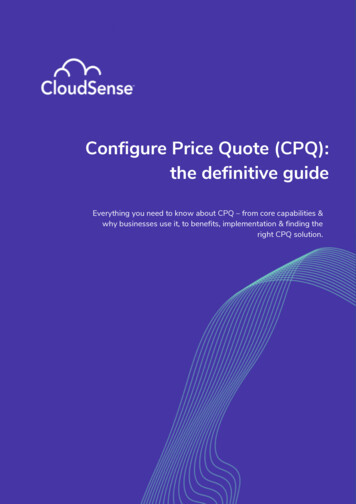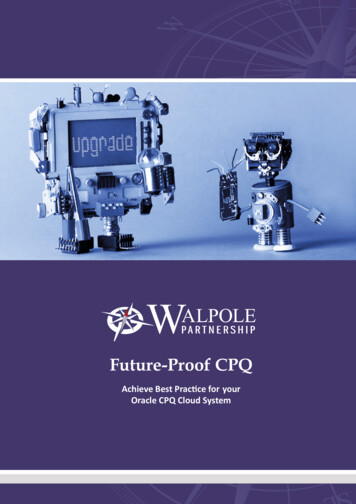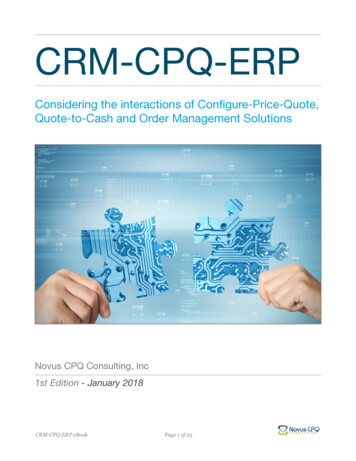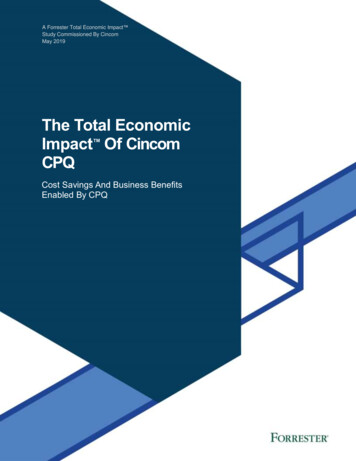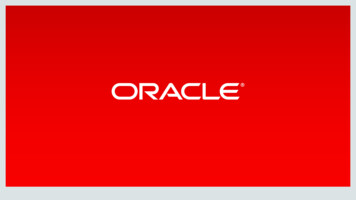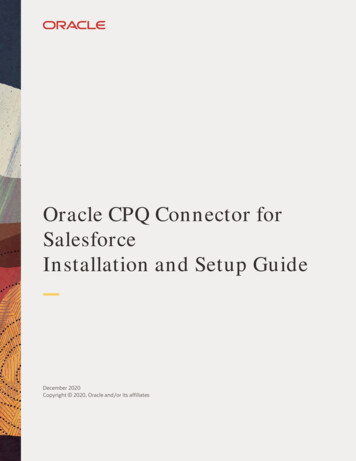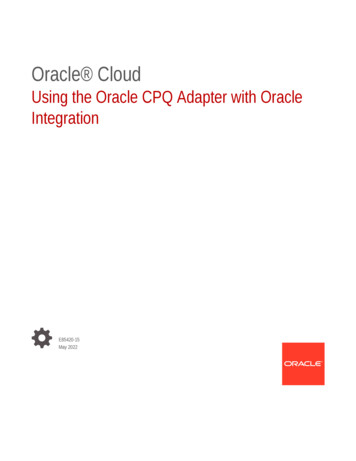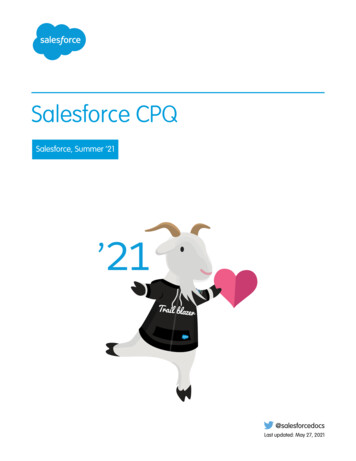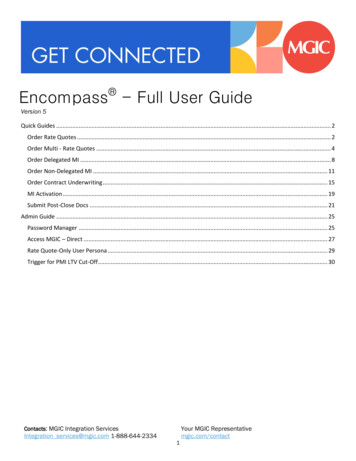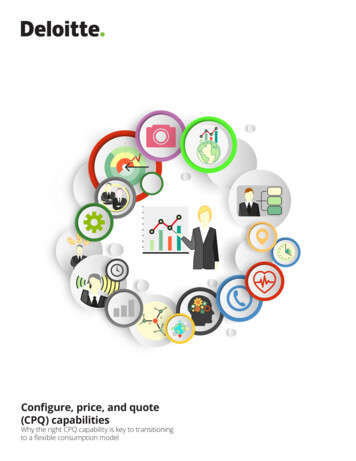
Transcription
Configure, price, and quote(CPQ) capabilitiesWhy the right CPQ capability is key to transitioningto a flexible consumption model
Configure, price, and quote (CPQ) capabilities IntroductionConfigure, price,and quote (CPQ)capabilitiesWhy the right CPQ capability is key to transitioning to a flexible consumption modelMany companies are moving away from traditional business models to flexible consumptionbased ones—a transition that requires reengineering the value chain and realigning teamsto the new business model. In our previous articles, we talked about the capabilities andtechnology platforms needed to support a flexible consumption model (FCM) in the as-aservice economy. In this article, we discuss one key aspect of the go-to-market capability,which is the CPQ processes of the lead-to-cash cycle. It’s essential to align the CPQ processeswith the flexible consumption strategy to enable direct sales, channel partners, andcustomers to easily configure, price, and quote as-a-service solutions.CPQ processes in flexible consumption business models provide capabilities to support adiverse set of products portfolio, complex offerings with multiple features, and complexpricing structures. With expanding customer channels and partners, and the increasingcomplexity of product structures and pricing strategies in consumption-based models,the approach for CPQ needs to be transformed for efficient sales operations. Such a CPQprocess can have the capabilities depicted in figure 1.Figure 1. CPQ capability mapConfigure, price, and quoteGuidedsellingStandardand nonstandard dealmanagementQuoteto orderconversionProductand tsAnalytics2
Configure, price, and quote (CPQ) capabilities Potential benefits of CPQPotential benefits of CPQCPQ offers a range of potential benefitsfor companies transitioning to flexibleconsumption models.Supports diverse products withcomplex pricing: With FCMs, customerspay only for the products or featuresthey use. This means organizations needto develop and offer their products andservices in a modular fashion (standard andnonstandard bundled offerings). Pricingis defined for each feature, and there’sflexibility to set discounts and margins atvarious levels, such as bundle, deal, and lineitem.Shortens sales cycle: A well-designedCPQ process integrates organizations withtheir channel partners in the sales cycle.Organizations can define the steps toauto-validate and auto-book a segment ofincoming legal quotes to orders, reducingthe overall time within the sales cycle. Thetime required by sales reps to interactwith other teams to gather informationand seek approvals and responses canbe reduced by clearly outlining rules forapproval management and streamliningthe processing of all requests. Sales repscan also quickly analyze the effectivenessof each deal by determining potentialcost, margins, profitability, and other keyperformance indicators (KPIs) to ensure thatthe deal is aligned with business objectives.3Some of the key metrics that are relevantfor managing CPQ process include: quoteaccuracy rate, quote turnaround time,standard to nonstandard deal ratio, quoteconversion rate, and self-service quote ratio.Helps reduce inadvertent quotingerrors: Manual configuration of quotesoften leads to errors, which in turn can leadto revenue loss and erosion of customerconfidence. Developing optimal quotes is achallenge in the case of complex productsand large orders. CPQ helps ensure errorfree sales quotes and proposals that alignwith customer requirements. Throughbusiness rules, discounts are capped, andquotes don’t fall below a defined marginvalue. At the same time, automated quotegeneration increases quoting accuracy andsale closure rate, while decreasing falloutrate.Key considerationsfor CPQ Reevaluate and reengineerbusiness processesThe CPQ process for flexibleconsumption will need to supporta range of capabilities, from flexiblepricing mechanisms to smarterrenewal management. Align and integrate withupstream and downstreamprocessesCompanies will need to adjust andenhance their current quote-tocash processes to accommodateflexible consumption. Assess and align architecturewith business processesSystem architecture needs toevolve from monolithic to scalableand modular architecture tosupport the flexibility of CPQprocesses. Train and reskill workforceSuccessful adoption of the CPQprocesses and system requireproper training and reskilling ofsales operations team and channelpartners.
Configure, price, and quote (CPQ) capabilities Reevaluate and reengineer business processesReevaluate and reengineer business processesEnterprise companies with traditionalbusiness models tend to develop siloedteams and disjointed processes over time.In addition, the startups and small-mediumbusinesses tend to have manual andnonstandardized processes, as focus is onrevenue growth. To enable configuration ofdiverse and complex as-a-service offeringsand efficient flow of information (e.g.,pricing) across sales and channel partners,and reduce sales cycle time, CPQ processfor flexible consumption models shouldconsider the following: Guided selling: Traditional businessmodels rely primarily on preconfiguredbundles. Consumption-based models, onthe other hand, are typically best servedby a guided-selling process that usesconsumption history and other customerdata—as well as preconfigured bundlesand partner-specific product options—todesign bundles. Dynamic configuration: Automatedrules, attributes, and hierarchy-basedconfiguration with ability to handle acombination of hierarchies for complexas-a-service offerings. Flexible pricing: CPQ should supportrelevant monetization mechanisms,such as flat subscription, tiered pricing,consumption-based pricing, or outcomebased royalty. A flexible consumptionCPQ process should allow dynamicpricing based on market conditions, easydistribution of pricing data across channelpartners, and point-of-sale systems, andsupport complex pricing rules. Smarter approval management:Instead of using offline approvals,the CPQ process should be based onworkflows and business rules. Apart fromstreamlining the approval process andreducing approval times, this approachalso helps in maintaining audit trails.Business rules should allow provisionsfor parallel approvers; reroute approvalrequests; and define auto-approvalworkflows for specific product bundleswith preset discounts based on customerand partner qualifications. Auto renewal management: Therenewal management process willneed to be enhanced to supportconsumption-based models. It shouldallow representatives to use existingentitlements and revise auto-generatedrenewal quotes for upsell, cross-sell, coterm, or return-to-support opportunities,if needed.This enables an organization to havea 360-degree view of all products andservices purchased by the customer. Standardized downstream processes:Standardization of downstreamprocesses such as subscriptionmanagement and billing can make theoverall sales process more predictableand repeatable, lowering maintenancecosts and increasing order velocity. Inaddition, standardized processes typicallyyield cleaner and richer data, which canbe used to model deal insights for betterdecision making. Future Opportunities and Renewals:CPQ platforms can determine pipelinesand forecast orders based on customerbuying patterns. It also triggers alerts forproduct upgrade and renewals. Asset-based ordering (ABO): ManyCPQ vendors are proactively enablingABO functionality in their solutions,thereby moving this functionality fromback office to front office. ABO enablesan organization to treat hardwareand software as an “asset” during thesales, delivery, and support life cycle.4
Configure, price, and quote (CPQ) capabilities AlignCPQ acceleratesand integratesaleswithacrossupstreamchannelsand downstream processesAlign and integrate with upstream and downstream processesThe CPQ journey yields great rewardsbut is also fraught with challenges. CPQprocess is integral to multiple upstream anddownstream processes across the offer-tocash life cycle (see figure 2). Adopting CPQrequires carefully evaluating and redefiningeach of those processes. Adjustments canrange from changing the way product andservice offerings are designed (SKU-basedto attribute-based model) to altering howrevenue is recognized (one-time up frontto ratably over the period of subscriptionterm).Figure 2. Interaction of CPQ with other processes in order-to-cash cyclePlatform/productCPQ to d andmodular products andpricing structuresStandardizedbillingProduct dataSKU to attribute-based modelCentralized quote mgmt.and consistent unitof measurementAccurate andtimely invoicingAutomated quote, approval,and order processingCentralized complianceto legal requirementsClear entitlementsidentificationConsistent pricing,discounting, and quotingenabling greater complianceDriversKey benefitsIn traditional business models, organizationsoften create a unique identifier, knownas a stock-keeping unit (SKU), for eachproduct and service. To expand customerbase and drive sales, the sales team oftencustomizes product attributes and pricingterms resulting in multiple SKUs per product(SKU proliferation). SKU proliferation canresult in operational inefficiencies suchas increasing the sales cycle and higheroperational cost due to convoluted productconfiguration and pricing business rules.5Prior to starting the CPQ transformationjourney, organizations should simplifyproduct structures (e.g., standardize pricingattributes, reduce product variations, etc.)and rationalize associated SKUs or move toan attribute-based product data model. Anattribute-based model can provide multiplebenefits such as increasing deal velocity,reducing pricing errors, reducing compliancerisk, and improving channel partneroperations.Standardized andquick revenuerecognition
Configure, price, and quote (CPQ) capabilities Assess and align architecture with business processesAssess and align architecture with business processesFor a CPQ system to support flexibleconsumption, the architecture needsto move from a monolithic applicationbase that works on a set of static rules toa scalable and modular one that allowscustomer data to be mapped to differentservices at different times. As opposedto linear and discrete models of the past,models that support flexible consumptionneed to accommodate a tiered pricingstructure, subscription billing, and recurringrevenue. Such an evolution would requirean evaluation of existing applications,integrations, and infrastructure to identifyand address individual gaps. The resultingnew architecture (see figure 3) should beable to break open the silos and bringtogether all teams involved in the lead-tocash process—from sales to collections.Figure 3. CPQ high-level technical architectureHigh-level technical architectureConfigure "e forselect partnersPartnerPortalCPQQuote to walsAsset-basedOrderingPricing/quoting dataAsset write backERPPricing/quoting dataOpportunity created for quotingSubscriptionbilling platformCRMProductdata modelTrain and reskill the workforceIt’s critical for teams involved in the salesprocess to embrace and adopt the newCPQ process and system. This means theywill have to be trained on new businessprocesses for their daily operations. Salesoperations and channel partners should bewell trained on new CPQ capabilities, suchas asset-based ordering and guided selling,to communicate with and quickly respond toprospects and customers. In addition, thetransition will require teams to move fromtraditional tools to new digital solutions.These solutions, which are often cloudbased, can provide better functionality butalso call for a different user interface andworkflows. Training programs need to becarefully designed to equip teams with theknowledge to perform their day-to-dayoperations following the transition. Thesechanges, while fundamental, aren’t easy toachieve. Redefining roles and responsibilitiesof business functions, deep-dive trainings,pilot runs, and closely monitoring thetransition are essential for ensuringsuccessful implementation and adoption ofCPQ processes.6
Configure, price, and quote (CPQ) capabilities Let’s talkLet’s talkEvery organization shoulddifferentiate itself throughexclusive product offersand pricing structures,making it imperative toget the most out of CPQcapabilities. A streamlinedCPQ process that integratesall relevant teams (sales,service provisioning, andinvoicing—as well asexternal partners) is difficultto design, yet it’s essentialfor the successful transitionto flexible consumptionbased models.At Deloitte, we understandthe complexity of thischallenge. We’ve workedwith numerous companiesto develop capabilitiesacross the entire lead-tocash cycle that supportflexible consumption—fromdefining a roadmap andestablishing an architectureto reskilling their workforce.Let’s talk about what thischange could mean for you.7
Contact usIf you have any questions about the information in this publication, please contact us:Jagjeet GillPrincipalDeloitte Consulting LLPjagjgill@deloitte.comGaurav MathurManagerDeloitte Consulting LLPgaumathur@deloitte.comThis publication contains general information only and Deloitte is not, bymeans of this This publication is not a substitute for such professional adviceor services, nor should it be used as a basis for any decision or action that mayaffect your business. Before making any decision or taking any action thatmay affect your business, you should consult a qualified professional advisor.Deloitte shall not be responsible for any loss sustained by any person who relieson this publication.About DeloitteDeloitte refers to one or more of Deloitte Touche Tohmatsu Limited, a UKprivate company limited by guarantee (“DTTL”), its network of member firms,and their related entities. DTTL and each of its member firms are legallyseparate and independent entities. DTTL (also referred to as “Deloitte Global”)does not provide services to clients. In the United States, Deloitte refers to oneor more of the US member firms of DTTL, their related entities that operateusing the “Deloitte” name in the United States and their respective affiliates.Certain services may not be available to attest clients under the rules andregulations of public accounting. Please see www.deloitte.com/about to learnmore about our global network of member firms.Copyright 2019 Deloitte Development LLC. All rights reserved.
workflows and business rules. Apart from streamlining the approval process and reducing approval times, this approach also helps in maintaining audit trails. Business rules should allow provisions for parallel approvers; reroute approval requests; and define auto-approval workflows for specific product bundles with preset discounts based on .
